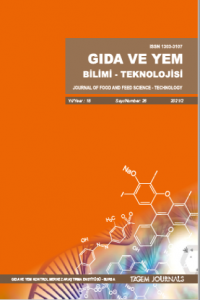Farklı Kurutma Yöntemlerinin Alkaya Kayısı Çeşidinin Toplam Fenolik İçeriğine Etkisi
Özet Amaç: Malatya kayısıları fenolik bileşikler
bakımından oldukça önemli bir kaynaktır. Fenolik bileşikler gıdalarda tat-koku
oluşumundaki etkileri, antioksidan ve antimikrobiyal etkiye sahip olmaları
bakımından önem taşırlar. Bu çalışmada farklı kurutma tekniklerinin Alkaya
kayısı çeşidinde bulunan fenolik bileşikler üzerindeki etkisi incelenmiştir. Materyal ve Yöntem: Bu amaçla Alkaya kayısı örneğine güneşte
kurutma (GK), kükürtlü kurutma (KK) ve fırın kurutma (FK) yöntemleri
uygulanmıştır.
Bulgular ve Sonuç: Toplam fenolik madde miktarı (TFM)
Folin-Ciocalteu yöntemi modifiye edilerek spektrofotometrik olarak 765 nm dalga
boyunda saptanmıştır. Örneklerin TFM değerleri Gallik Asit Eşdeğeri (GAE)
cinsinden hesaplanmıştır. Alkaya yaş kayısı örneğinde TFM miktarı 268,97 mg
GAE100g KM-1 saptanırken, GK, KK ve FK yöntemlerinde sırasıyla
179,91, 451,67 ve 167,13 mg GAE100g KM-1 TFM miktarları tespit
edilmiştir. KK yönteminde kükürt uygulaması ve miktarına bağlı olarak TFM
miktarında artış saptanmıştır. Abstract
Objective: Malatya apricots are an important source
of phenolic compounds. Phenolic compounds are important in terms of their
effects on taste-smell formation and antioxidant and antimicrobial effect in
foods. In this study, the effect of different drying techniques on phenolic
compounds in Alkaya apricot cultivars was investigated.
Materials and Methods: For this purpose, sundried (S), sulfur
drying (SD) and oven drying (OD) methods were applied to Alkaya apricot sample.
Resultand and Conclusion: The amount of total phenolic content
(TPC) was modified determined spectrophotometrically at a
wavelength of 765 nm by modifying the Folin-Ciocalteu method. TPC amount values
of the samples were calculated in Gallic Acid Equivalent (GAE). While the
amount of TFM in the apricot sample was 268.97 mg GAE100g KM-1, it
was determined that the amounts of 179.91, 451.67 and 167.113 mg GAE100g KM-1
TPC were determined respectively in S, SD and OD methods.
Anahtar Kelimeler:
Alkaya Apricot, Different Drying Methods, Total Phenolic Content
___
- Abdelhaq, E., H. and Labuza, T.P., 1987. Air Drying Characteristics of Apricots, Journal of Food Science, 52, 342-345
- Acar, J ve Gökmen, V., 2005. Meyve ve Sebze İşleme Teknolojisi, Cilt 1- Meyve ve Sebze Suları Üretimi, Hacettepe Üniversitesi Yayınları, ISBN: 975-491-179-7, Ankara, 674s.
- Akın, E.B., Karabulut, İ. ve Topcu, A., 2008. Some Compositional Properties of Main Malatya Apricot (Prunus armeniaca L.) Varieties. Food Chem. 107, 939–948.
- Alper, N., 2001. Nar Suyu Üretimi Üzerine Araştırmalar, Doktora Tezi, Hacettepe Üniversitesi Fen Bilimleri Enstitüsü, Ankara, 151s.
- Alzamora, S. M., Salvatori, D., Tapia, M. S., Lopez-Malo, A., Welti-Chanes, J. and Fito, P., 2005. Novel Functional Foods from Vegetable Matrices Impregnated with Biologically Active Compounds. J. Food Eng. 67, 205–214.
- Arias, E., Gonzalez, J., Lopez-Buesa, P. and Oria, R., 2008. Optimization of Processing of Fresh-Cut Pear. J. Sci. Food Agr. 88, 1755-1763.
- Asma, B. M., 2000. Kayısı Yetiştiriciliği. Evin Ofset Matbaası, Malatya, 243 s.
- Asma, B.M., 2011. Her Yönüyle Kayısı. İnönü Üniversitesi Fen Edebiyat Fakültesi, Biyoloji Bölümü, Malatya, 20-23 s.
- Brekke, J.E. and Nury, F.S., 1964. Fruits. In Food Dehidration, W.B.V. Arsdel and M.J. Copley (Eds.), Vol. II, AVI Publishing Co., Westport, CT.
- Çam, M., Hışıl Y., 2003. Gıdalardaki Flavonoidler ve Önemleri, 3. Gıda Mühendisliği Kongresi, 2-4 Ekim, Ankara, Türkiye, s.67-82
- Cemeroglu, B. ve Özkan, M., 2004. Kurutma Teknolojisi. Meyve ve Sebze İşleme Teknolojisi, B. Cemeroğlu (ed), Başkent Klişe Matbaacılık, s. 479-618, Ankara
- Doymaz, İ., 2004. Effect of Pre-Treatments Using Potassium Metabisulphide and Alkaline Ethhyl Oleate on the Drying Kinetics of Apricots, Biosystems Engineering, 89 (3), 281-287.
- Dragovic-Uzelac, V., Delonga, Levaj, B., Djakovic, S. and Pospisil, J., 2005. Phenolic Profiles of Raw Apricots, Pumpkins, and their Purees in the Evaluation of Apricot Nectar and Jam Authenticity. J. Agr.Food Chem. 53, 4836-4842.
- Garcia-Alonso, M., Pascual-Teresa, S., Santos-Buelga, C. and Rivas-Gonzalo, J.,C., 2004. Evaluation of the Antioxidant Properties of Fruits, Food Chemistry, 84 (1), 13-18.
- Güçlü, K., Altun, M., Özyürek, M., Karademir, S. E. and Apak, R., 2006. Antioxidant Capacity of Fresh, sun- and Sulphited-Dried Malatya Apricot (Prunus armeniaca) assayed by CUPRAC, ABTS/TEAC and Folin Methods. International Journal of Food Science and Technology, 41: 76–85.
- Heim, K.E., Tagliaferro, A.R. and Bobilya, D.J., 2002, Flavonoid Antioxidants: Chemistry, Metabolism and Structure-Activity Relationships. Journal of Nutritional Biochemistry, 13: 572-584.
- Özkan M. 2001. Kuru Kayısılardan Kükürt Dioksitin Uzaklaştırılma Yöntemleri Üzerinde Araştırma. Doktora Tezi (basılmamış), Ankara Üniversitesi, 113 s., Ankara.
- Re, R., Pellegrini, N., Proteggente, A., Pannala, A., Yang, M. and Rice-Evans, C., 1999. Antioxidant Activity Applying an Improved ABTS Radical Cation Decolorization Assay. Free Radical Biology and Medicine, 26(9), 1231-1237.
- Ruiz, D., Egea, J., Tomas-Barberan, F.A. and Gil, M.I., 2005. Characterization and Quantitation of Phenolic Compounds in New Apricot (Prunus armenica L.) Varieties, J. Agric. Food Chem., 53 (24), 9544-9552
- Thaipong, K., Unaroj, B,, Crosby, K., Cisneros-Zevallosc, L. and Byrne, D.H., 2006. Byrnec Comparison of ABTS, DPPH, FRAP, and ORAC Assays for Estimating Antioxidant Activity from Guava Fruit Extracts Journal of Food Composition and Analysis 19 (2006) 669–675
- ISSN: 1303-3107
- Yayın Aralığı: Yılda 2 Sayı
- Başlangıç: 2015
- Yayıncı: Bursa Gıda ve Yem Kontrol Merkez Araştırma Enstitüsü
Sayıdaki Diğer Makaleler
Alternative Techniques For Fruit and Vegetable Waste Valorization in Turkey
Banu AKGÜN, Nurcan AYŞAR GÜZELSOY, Arzu YAVUZ, Yıldıray İSTANBULLU, Ahmet BUDAKLIER
Natürel Sızma Zeytinyağlarında Bazı Pestisit Kalıntılarının GPC-GC Yöntemiyle Belirlenmesi
Sema DEMİR, Hakan TOSUNOĞLU, Altan DENİZ
Farklı Kurutma Yöntemlerinin Alkaya Kayısı Çeşidinin Toplam Fenolik İçeriğine Etkisi
Mustafa KAPLAN, Sevgi ESKİGÜN, Okan LEVENT, Harun DIRAMAN, Azize ATİK
Elma Dilimlerinin Farklı Güneş Kurutma Yöntemleri ile Kurutulması
Gıda Güvenliği ve İnsan Sağlığı Açısından Çiğ ve Isıl İşlem Görmüş İçme Sütü Tüketimi
